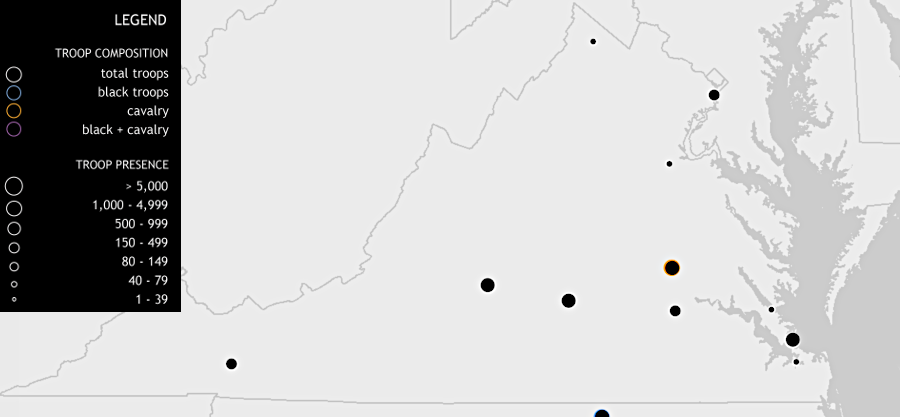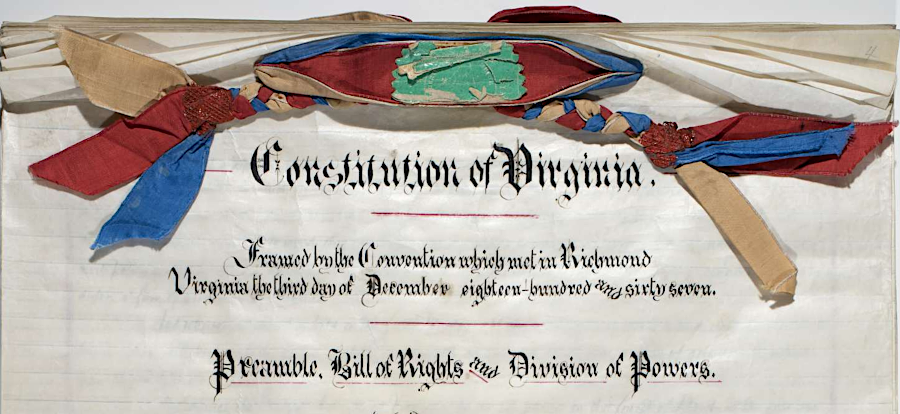
US Army posts in November 1867
Source: Gregory P. Downs and Scott Nesbit, Mapping Occupation: Force, Freedom, and the Army in Reconstruction

US Army posts in November 1867
Source: Gregory P. Downs and Scott Nesbit, Mapping Occupation: Force, Freedom, and the Army in Reconstruction
After the surrender of the Confederate armies, President Andrew Johnson considered provisional governments as the legitimate authorities in the conquered region. On June 19, 1865, a special session of the General Assembly of the Restored Government of Virginia scheduled an election for October 12, 1865 to elect new members of the US House of Representatives, plus new members of the House of Delegates and State Senate.
Many of the initial candidates for the US House of Representatives could not honestly take the test oath required to be seated. Nearly all withdrew before the election, in response to concerns that readmission to the Union would be delayed if former Confederates were elected. Despite the election of six people in Virginia's eight districts who could take the oath, the Congress refused to seat all of the winners when it met in December, 1865.1
In the 1866 election, Radical Republicans took control of the US Congress with enough members to overturn vetoes by President Andrew Johnson. In the "Act to Provide for the More Efficient Government of the Rebel States," all former Confederate states except Tennessee were restructured into five military districts. The law, the first of the Reconstruction acts, defined requirements for the states to be readmitted into the Union.
Virginia was designated in the law as the "First Military District," and is traditionally described as Military District No. 1. In the three years before Virginia completed the required tasks to be readmitted, four US Army generals were appointed to serve as the chief executives, with the power to appoint the state governor.
The first, Major General Schofield, appointed Henry H. Wells to serve as governor of Virginia. He made that decision in 1868, near the end of the term for which Governor Francis H. Pierpont had been elected in 1864 during the period of the Restored Government of Virginia.
After General Schofield was chosen to become Secretary of War later in 1868, Major General Stoneman was given the responsibility of governing Military District No. 1. He was followed by Brigadier General Alexander S. Webb, and finally by Brigadier General Canby.2
General Schofield was in charge in 1867 when voters selected representatives to a convention that would write a new state constitution. Voters were required to swear that they had not supported the Confederacy, disfranchising all former soldiers and leaders. Whites chose to sit out the election, rather than take the "iron clad" oath.3
Newly-freed African American men were allowed to vote, and 24 were elected to what became known as the Underwood Convention. The convention met in Richmond from December 3, 1867, through April 17, 1868, and ultimately approved a document which disfranchised former Confederate leaders. White conservatives refused to concur, and military rule was extended until a compromise was reached to allow a separate vote on the disfranchisement clauses. By mid-1869, all other states had been re-admitted into the Union except Virginia, Mississippi, and Texas.
In a July 1869 election, voters approved the new constitution but rejected the clauses. The US Congress and President Grant accepted the new constitution without the rejected clauses.4

to end military rule, Virginia had to adopt a new state constitution and ratify the 14th and 15th amendments to the US Constitution
Source: Library of Virginia, Constitutional Convention
The 1869 election also chose the next governor and members to an 1869 session of the House of Delegates and State Senate. The legislature met in October, 1869 and ratified the Fourteenth and Fifteenth amendments to the U.S. Constitution. The US Congress admitted Virginia's newly-elected Representatives and Senators in January, 1870 and military rule ended with the installation of the new governor.5